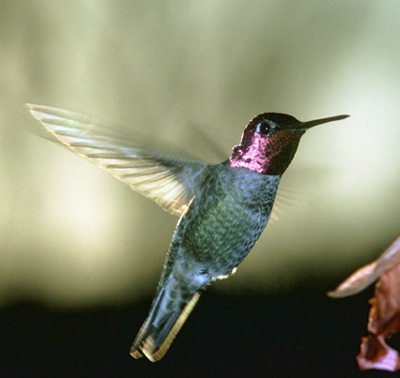
Hummingbirds are birds that comprise the family Trochilidae. They are among the smallest of birds, most species measuring in the 7.5–13 cm (3–5 in) range. Indeed, the smallest extant bird species is a hummingbird, the 5-cm Bee Hummingbird. They can hover in mid-air by rapidly flapping their wings 12–90 times per second (depending on the species). They are also the only group of birds able to fly backwards. Their English name derives from the characteristic hum made by their rapid wing beats. They can fly at speeds exceeding 15 m/s (54 km/h, 34 mi/h).

Hummingbirds drink nectar, a sweet liquid inside certain flowers. Like bees, they are able to assess the amount of sugar in the nectar they eat; they reject flower types that produce nectar that is less than 10% sugar and prefer those whose sugar content is stronger. Nectar is a poor source of nutrients, so hummingbirds meet their needs for protein, amino acids, vitamins, minerals, etc. by preying on insects and spiders.

Most hummingbirds have bills that are long and straight or nearly so, but in some species the bill shape is adapted for specialized feeding. Thornbills have short, sharp bills adapted for feeding from flowers with short corollas and piercing the bases of longer ones. The Sicklebills' extremely decurved bills are adapted to extracting nectar from the curved corollas of flowers in the family Gesneriaceae. The bill of the Fiery-tailed Awlbill has an upturned tip, as in the Avocets. The male Tooth-billed Hummingbird has barracuda-like spikes at the tip of its long, straight bill.

The two halves of a hummingbird's bill have a pronounced overlap, with the lower half (mandible) fitting tightly inside the upper half (maxilla). When hummingbirds feed on nectar, the bill is usually only opened slightly, allowing the tongue to dart out and into the interior of flowers.

Like the similar nectar-feeding sunbirds and unlike other birds, hummingbirds drink by using protrusible grooved or trough-like tongues. Hummingbirds do not spend all day flying, as the energy cost would be prohibitive; the majority of their activity consists simply of sitting or perching. Hummingbirds feed in many small meals, consuming many small invertebrates and up to twelve times their own body weight in nectar each day. They spend an average of 10–15% of their time feeding and 75–80% sitting and digesting.


